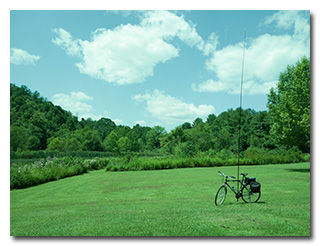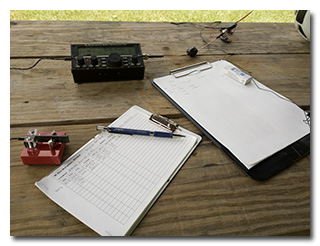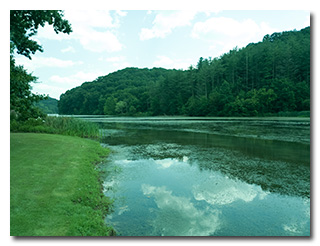
by William Eric McFadden
From the Strouds Run State Park website:
-
Several mounds and ancient fortifications were found in this area by early settlers telling us that the Adena Indians once lived here. In more recent history, this was home to the powerful Shawnee Nation until the Treaty of Greenville forced them to abandon their lands in southern Ohio.
The first European settlers arrived in the Athens County region in 1796. Two townships of land in the area had been apportioned by the Ohio Company in 1795 for the benefit of a university. The newly arrived pioneers were encouraged to settle on these college lands so as to make them attractive, productive and to form a fund for the institution.
This venture led to the founding of the town of Athens and Ohio University, the first college in the Northwest Territory. Settlers came by way of flatboats from Marietta down the Ohio and up the Hocking River to an attractive bluff where the town of Athens is now located.
With the discovery of rich coal fields in the area, Athens County soon developed into one of the leading coal producers in the state. The Hocking Canal and railroads provided easy means for shipping coal to distant markets. Clay tile, brick and salt were other industries that brought prosperity to the area.
The park derives its name from the Strouds family who settled in the area in the early 1800s. The land was purchased by the state for forest conservation purposes from 1948 to 1953. The dam creating Dow Lake was completed in 1960. The lake bears the name of C.L. Dow of Ohio University who was instrumental in initiating the project.
Pictures
Description
On Friday, August 18, 2023, one member of the Southeast Ohio Radio Adventure Team performed a successful bicycle-portable activation of Strouds Run State Park (K-1994) as part of the Parks on the Air (POTA; link) program.
On a beautiful day that was not too hot and just a little bit blustery, Eric McFadden, WD8RIF, bicycled from his home to Strouds Run State Park in early afternoon with his small and lightweight KX2 Mini Travel Kit.
Eric began his ride from home at 1619 UTC and arrived at Bulldog Shelter in Strouds Run State Park at about 1711 UTC. He was pleased to find the picnic shelter to be occupied by one couple who were glad to share the shelter.
Eric set up his Elecraft KX2 transceiver on an available picnic table, bungied his Goture Red Fox Super Hard 720 carbon-fiber mast vertically to his bicycle, sloped the Tufteln (link) 35' EFRW antenna from the KX2 up to top of the mast, and deployed three 17' counterpoise wires—using the Tufteln Antenna Counterpoise Add-On Kit—directly on the ground. Eric was on the air at 1722 UTC.
As at nearly all of his previous operations at this location, Eric had good cell-signal and would be able to spot himself on the POTA Spots website and to use POTA Spots to identify possible Park-to-Park (P2P) QSOs.
Eric decided to start on 20m and, as he was tuning around to find a clear frequency, he found a station calling "CQ POTA". Eric answered this station and at 1723 UTC he completed a P2P QSO with K2UPD at Beebe Hill State Forest (K-5117) in New York.
After the first QSO, Eric decided 40m might be more lucrative. He found himself a 40m frequency, began calling "CQ POTA", and was auto-spotted on POTA Spots. Eric's first QSO in this run came at 1730 UTC with KT4U in Kentucky. The 40m band was not lucrative and QSOs came slowly, with Eric's fourth QSO in this run coming at 1739 UTC with KB3AAY in Maryland. This run included QSOs with operators in Kentucky, Ohio, Virginia, and Maryland.
Switching to 30m, Eric found a clear frequency to run, began calling "CQ POTA", and was auto-spotted on POTA Spots. Eric's only QSO on 30m came at 1746 UTC with WI1G in Massachussetts.
Checking POTA Spots for P2P QSO opportunities, at 1755 UTC Eric completed a P2P QSO on 20m with WI5D at Hillsdale State Wildlife Area (K-7929) in Kansas.
Eric found himself a clear frequency on 20m to run, began calling "CQ POTA" and self-spotted himself on POTA Spots. His first QSO in this run came at 1758 UTC with W9MET in Florida. QSOs came quickly, with Eric's eighth QSO in this run coming at 1808 UTC with NU7J in Washington. This run included a P2P QSO with AC3IE at Lock 32 Canal State Park (K-2097) in New York and QSOs with operators in Florida, Texas, New York, Idaho, North Carolina, Oklahoma, Quebec, and Washington.
Eric finished his activation by hunting for P2P QSOs. At 1811 UTC, he completed a P2P QSO on 20m with AD0IM at Middle Creek State Fishing Lake (K-7392) in Kansas. At 1812 UTC, he completed a P2P QSO on 20m with K4TNE at Goose Creek State Park (K-2731) in North Carolina. Finally, at 1817 UTC, he completed a P2P QSO on 40m with K1SEI at Cockaponset State Forest (K-7531) in Connecticut.
In all, Eric logged eighteen QSOs, with six P2P QSOs, in fifty-five minutes of on-air time. All of Eric's QSOs were CW and were made at five watts output.
Again, the KX2 and the Tufteln 35' EFRW antenna performed well. Eric was pleased that the bicyle and mast remained stable during wind gusts and weren't blown down.
Eric took some photos, tore down his station, loaded his bicycle, and began his ride home.
Eric also submitted his log to the World Wide Flora and Fauna in Amateur Radio (WWFF; link) program for an activation of Strouds Run State Park, KFF-1994.
(return)


